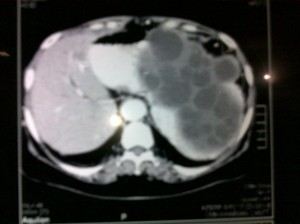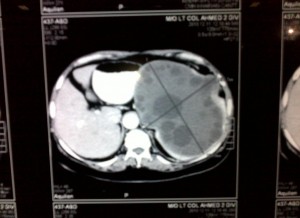Maqsood Ahmad, FCPS*, Muhammad Saqib, FCPS**, Mumtaz Ahmad, FCPS***, Muhammad Raees, FCPS****
*Consultant anesthesiologist, CMH Gujranwala.
**Consultant anesthesiologist, PAF Hospital Rafiqui Shorkot Cantt.
*** Consultant surgeon, Nescom Hospital Islamabad.
****Consultant surgeon, CMH Gujranawala.
Correspondence: Dr Maqsood Ahmad, FCPS Classified Anaesthetist Combined Military Hospital Gujranwala (Pakistan)
ABSTRACT
Hydatid disease is caused by the infestation of larvae of Taenia Echinococcus (TE). Humans are infected through faeco-oral route by the ingestion of food and milk, contaminated by dog faeces containing the ova of parasite or direct contact with dogs. After coming out of eggs in the gut, larvae get into the portal circulation and pass through the liver which acts as the first filter. Most of the larvae settle in the liver and lungs, rarely passing to other organ like brain, spleen and mesentery. We describe an incidental finding of huge hydatid cyst spleen in an old lady who presented with long standing generalized vague complaints. The complete removal of cyst was performed with partial splenectomy.
Key words: Hydatid cyst; Splenectomy; Laparotomy; Old age
Citation: Ahmad M, Saqib M, Ahmad M, Raees M. Removal of a large hydatid cyst in spleen. Anaesth Pain & Intensive Care 2011;15(1):48-50.
INTRODUCTION
Hydatidosis is endemic in many Mediterranean countries, the Middle East, South America, Australia, New Zealand, Africa and other parts of the world. It is caused by an infection from echinococcus granulosus larvae which can lead to the development of cysts. The most frequently affected organs are the liver and lungs. Splenic hydatid cysts alone are very rare. Humans are incidental host who contract the disease by ingesting highly infective eggs of adult echinococcus, harbouring in the small intestine of the definitive hosts like dogs and other canine animals. Splenic hydatid cysts, being a rare entity, can occur primarily or in association with hepatic, pulmonary or multi organ hydatidosis1. Open splenectomy is the standard procedure for benign disorders and laparoscopic hydatid cystectomy has also been reported. We report a case of incidental finding of this condition in an old hypertensive lady, who presented with unusual complaints.
CASE REPORT
A 79 years old female, weighing 85 kg, presented with complaints of malaise and generalized aches and pains in multiple joints. She was given symptomatic treatment for two weeks but this did not improve her symptoms. She had these complaints for the last 15 years. She was on tab atenolol 50 mg daily for her hypertension for the last 15 years. She reported with these complaints off and on to different outdoors and was always given symptomatic treatment, which continued for 2–3 years with no improvement. Interestingly, she had no abdominal complaints. Her investigations, e.g. blood complete picture, urine RE, blood sugar, blood urea and electrolytes and RA factor were within normal limits.
Figure 1: CT scan abdomen showing hydatid cyst in the spleen

Figure 2: CT scan abdomen showing another view of hydatid cyst

At her latest visit, she complained of some heaviness in her abdomen along with generalized complaints. Her abdominal examination revealed her spleen to be enlarged; and ultrasound abdomen revealed a huge cystic mass in spleen measuring 20×20 cm. A CT scan abdomen confirmed the diagnosis of hydatid cyst spleen (Fig 1&2). Her lab reports were normal except her hemoglobin, which was 9.8 gm/dl and ECG which revealed symmetrical T wave inversion in V3-6 leads. She was prepared for splenectomy under general anaesthesia. In the operating room, routine basic monitoring was done. She was induced with propofol 150 mg and morphine 4mg bolus plus 1mg intra-operatively to deepen the anaesthesia. Inj. atracurium 35 mg was used and ETT 7 mm was placed. For maintenance isoflurane 1.2 % was used in oxygen and nitrous oxide. Atropine 0.5 mg was given during the operation when her heart rate dropped to 48/min. Intra-operatively she was transfused two pints of blood along with 2 liter of Ringers lactate solution. The cyst was punctured, aspirated and hypertonic saline was injected into the cyst repeatedly. Abdominal packs soaked with hypertonic saline were placed around the cyst during dissection. The rupture of cyst was inevitable in spite of careful dissection due to large adherent cystic mass hindering surgery but there was no anaphylaxis reaction. Partial splenectomy with complete removal of the cyst was performed. The surgery remained uneventful and she was shifted to ITC after smooth recovery.
DISCUSSION
Hydatid disease is a zoonosis caused by ingesting eggs of the parasite echinococcus granulosus in rural sheep farming regions. After ingestion, the eggs hatch and oncospheres penetrate the intestinal mucosa and enter circulation. The embryos are carried to the liver to be arrested in the sinusoidal capillaries (liver acts as first filter). Some of the embryos may pass through the hepatic capillaries and enter the pulmonary circulation and filter out in the lungs (lungs act as second filter). Wherever the embryo settles, it forms a hydatid cyst. Human echinococcosis is caused by the tapeworm of the genus echinococcus. Of the 4 known species of echinococcus, 3 are of medical importance in humans. These are echinococcus granulosus, causing cystic echinococcosis (CE): echinococcus multilocularis, causing alveolar echinococcosis (AE); and echinococcus vogeli2. Liver and lungs are the organs most commonly affected by this disease as evident by the life cycle of the parasite. Primary infestation of the spleen by the parasite is rare. The infection is usually acquired in childhood and mostly remains asymptomatic. The cyst grows slowly at a rate of 0.3-1 cm per year and sometimes it may take 5-20 years to grow into size to cause symptoms of abdominal discomfort3. Berlott (1790) was the first to describe splenic hydatidosis as an autopsy finding4. When the cyst attains a considerable size the patient becomes symptomatic and mostly presents with painful left upper abdominal mass. The diagnosis of hydatid cyst spleen in our case was an incidental finding, and initially she had only generalized vague complaints. The differential diagnoses for splenic hydatid cysts include other cystic lesions such as epidermoid cysts, pseudocysts, splenic abscesses, hematomas and cystic neoplasms of the spleen5,6. The PAIR approach is often used: puncture-aspirate cyst-inject hypertonic saline-reaspirate after 25 min. There is always a risk of spontaneous or traumatic rupture and anaphylaxis. The standard treatment is total or partial splenectomy; splenectomy without puncturing the cyst is preferable. We drained the cyst after puncturing it followed by partial splenectomy. Hypertonic saline was used during the procedure and although there was some spillage of cyst contents into peritoneal cavity, no adverse reaction was observed. Pre-operatively, she was prepared with albendazole, which is the mainstay of treatment. The morbidity is usually secondary to rupture of the echinococcal cyst (with or without anaphylaxis), infection of the cyst, or dysfunction of affected organs. The examples of dysfunction of affected organs are biliary obstruction, cirrhosis, bronchial obstruction, renal outflow obstruction, increased intracranial pressure secondary to mass, and hydrocephalus secondary to cerebrospinal fluid outflow obstruction. The most serious complication during surgery is IgE mediated anaphylactic reaction. Some reports have cited a 0.2-3.3% incidence of anaphylactic shock following surgical removal of hydatid cyst7. All preparatory measures must be at hand to deal with this adverse reaction promptly.
CONCLUSION
Hydatid cyst spleen is a rare but important diagnosis. An early diagnosis and treatment had an almost complete cure from the disease. Surgical excision is the mainstay of the treatment, but all preparatory measures must be undertaken to treat possible anaphylactic reaction.
REFERENCES
- Murtaza B, Gondal ZI, Mehmood A, ShahSS, Abbasi MH, Tmimy MS, et al. Massie splenic hydatid cyst. JCPSP 2005;15(9):568-70.
- Kir. A, Baran. E, Simultaneous operation for hydatid cyst of right lung and liver. Thorac cardiovasc Surgeon.1995;43:62-4.
- Wani NA, Tak S, Shah ND, Bashir A, Arif SM Bullet injury causing rupture of spleen with hydrated cyst. JK Prac 1998;5:55-56.
- Muro J et al. demonstration angiographica del quisite hidatidico de bazo. Rev Clin Esp 1969;115:433-438.
- Pedrosa I, Saiz A, Arrazola j, et al. Hydatid disease: radiologic and pathologic features and complications. Radiolgraphics. 2000;20:795-817.
- Durgun V, Kapan S, Kapan M, et al. Primary splenic hydatidosis. Dig Surg. 2003;20:38-41.
- Jakubowski MS, Barnard DE, Anaphylactic shock during operation for hydatid disease. Anesthesiology 1971;34:197-9.

